solving-africas-weed-problem-report1
solving-africas-weed-problem-report1
solving-africas-weed-problem-report1
You also want an ePaper? Increase the reach of your titles
YUMPU automatically turns print PDFs into web optimized ePapers that Google loves.
(50-80%), groundnut (80%), and cassava (90%) (Ambe et al., 1992; Akobundu, 1987; Olowe et al.,<br />
1987; Ishaya et al., 2007b; Ngouajio et al., 1997; Chikoye et al., 2004; Dadari & Mani, 2005).<br />
One kilogram of <strong>weed</strong>s reduced the yield of rice by 500-900 grams in a Nigerian experiment<br />
(Adeosun, 2008).<br />
Weeds need to be cleared from a field prior to planting a crop and <strong>weed</strong>s need to be removed<br />
from the field during the growing season for optimal yields to be achieved.<br />
Weed competition is most serious when the crop is young. The critical period of crop-<strong>weed</strong><br />
competition is approximately equal to the first one-third to one-half of the life cycle of the crop. In<br />
<strong>weed</strong>-crop competition studies, the “critical period” is the stage after which <strong>weed</strong> growth does not<br />
affect crop yields. Keeping the crop free of <strong>weed</strong>s for the first third of its life cycle usually assures<br />
near maximum productivity (Doll, 2003).<br />
African crops have been studied at experimental farms in order to define the <strong>weed</strong>-free period<br />
required to prevent yield reduction: (<strong>weed</strong>-free period [days] required after planting) maize, 56;<br />
rice, 42; sorghum, 35; cassava, 84; cowpea, 40 (Obuo et al., 1999; Akobundu, 1987; Ambe et al.,<br />
1992).<br />
Hand<strong>weed</strong>ing<br />
Hand <strong>weed</strong>ing is the predominant <strong>weed</strong> control practice on smallholder farms (Vissoh et al.,<br />
2004). Hand <strong>weed</strong>ing is the oldest method of <strong>weed</strong> control and consists of hand-pulling, handslashing<br />
and hoeing of <strong>weed</strong>s. Smallholder farmers spend 50-70% of their total labor time<br />
hand<strong>weed</strong>ing (Chikoye et al., 2007a).Women contribute more than 90% of the hand <strong>weed</strong>ing labor<br />
for most crops (Ukekje, 2004). 69% of farm children between the ages of 5-14 are forced to leave<br />
school and are used in the agricultural sector especially at peak period of <strong>weed</strong>ing (Ishaya et al.,<br />
2008b).<br />
- 4 -


